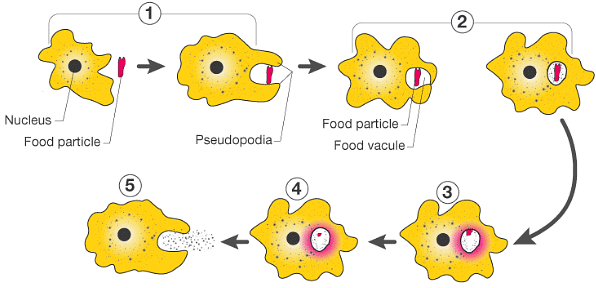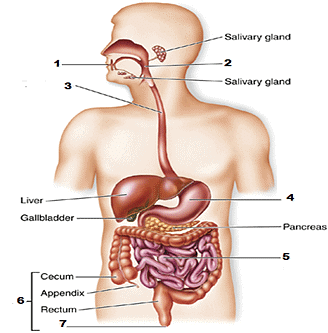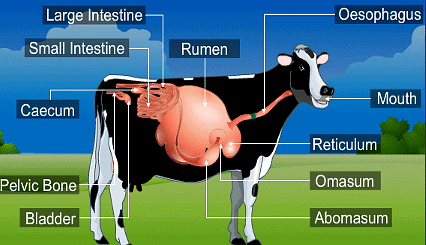Exercises: Nutrition in Animals | Class 7 Oxford Science: Chapter Notes, Worksheets & Tests PDF Download
| Table of contents |

|
| Objective type Questions |

|
| Very short answer type questions |

|
| Short answer type questions |

|
| Long answer type questions |

|
Objective type Questions
A. Fill in the blanks with the correct words.
Q.1. _____(Assimilation/Digestion) involves the use of simple substances to build complex substances required by the body.
Assimilation
Assimilation is the process by which nutrients from food are absorbed and used to build and repair tissues in the body.
Q.2. Once swallowed, the food passes down into a long tube called the _____(stomach/oesophagus).
oesophagus
The oesophagus is a muscular tube that connects the mouth to the stomach and is responsible for transporting food from the mouth to the stomach through rhythmic contractions.
Q.3. The process of digestion begins in the_____(mouth/stomach).
mouth
The process of digestion begins in the mouth where food is mechanically broken down by chewing and mixed with saliva, which contains enzymes that help to break down carbohydrates.
Q.4. The liver secretes the,_____(bile/pancreatic) juice.
bile
Bile is a greenish-yellow fluid that is produced by the liver and stored in the gallbladder. It aids in the digestion and absorption of fats by emulsifying them into smaller droplets.
Q.5. The digestion of various components of food is completed in the _____(large/small) intestine.
small
The small intestine is where most of the digestion and absorption of nutrients from food takes place. Enzymes produced by the pancreas and small intestine break down proteins, fats, and carbohydrates into smaller molecules that can be absorbed by the body.
Q.6. _____ (Rumen/Abomasum) is the last chamber of the stomach in ruminants.
Abomasum
Ruminants, such as cows, sheep, and goats, have a four-chambered stomach. The abomasum is the fourth and final chamber of the stomach and is similar in function to the stomach of non-ruminant animals. It is responsible for further breaking down and digesting food before it enters the small intestine.
B. Choose the correct option.
Very short answer type questions
Give two examples for the following.
Q.1. Organisms made of a single cell ____
Amoeba, Paramecium
Q.2. Outgrowths that help unicellular animals to catch food ____
Cilia, Flagella
Q.3. Digestive juices that aid in digestion ____
Enzymes, Hydrochloric acid
Q.4. Glands of the digestive system ____
Salivary gland, Pancreas
Short answer type questions
Q.1. How is ingestion different from egestion?
Ingestion is the process of taking in food or nutrients into the body, while egestion is the process of expelling waste products from the body. In other words, ingestion is about taking in food, and egestion is about eliminating waste.
Q.2. Name the four types of teeth and their main functions in the human jaw.
The four types of teeth in human beings are incisors, canines, premolars, and molars. Incisors are used for biting and cutting food, canines are used for tearing and ripping, premolars are used for crushing and grinding, and molars are used for grinding and mashing food.
Q.3. How do villi help in small intestines of human beings?
Villi are tiny finger-like projections that line the walls of the small intestine. They increase the surface area of the intestine, which helps in the absorption of nutrients. The villi contain blood vessels and lacteals, which absorb and transport nutrients to the bloodstream.
Q.4. What is rumination?
Rumination is the process by which certain animals, such as cows and sheep, regurgitate and rechew their food to aid in digestion. These animals have a four-chambered stomach that allows them to break down tough plant material by fermenting it with the help of microbes. They regurgitate the food back into their mouths and chew it again to further break it down before swallowing it once more.
Long answer type questions
Q.1. With the help of a well-labelled diagram, describe how an amoeba catches and digests its food.
An amoeba is a single-celled organism that captures and digests its food through a process called phagocytosis. Here is a well-labelled diagram describing how an amoeba catches and digests its food:
As shown in the diagram, the amoeba extends its pseudopodia (false feet) to surround and engulf its prey. The prey is then enclosed in a food vacuole, which is formed by the membrane of the pseudopodia. The food vacuole fuses with lysosomes, which contain digestive enzymes, to form a digestive vacuole. The enzymes break down the food into simpler molecules, which are then absorbed into the cytoplasm of the amoeba. The undigested waste is expelled out of the cell through the process of exocytosis.
Q.2. Explain the process of digestion in human beings.
Digestion is the process of breaking down complex food molecules into simpler forms that can be absorbed by the body. In human beings, the process of digestion involves several organs and enzymes. Here is a brief overview of the process:
Mouth: Digestion starts in the mouth, where teeth and tongue break down food into smaller pieces. Saliva, which contains the enzyme amylase, begins the breakdown of carbohydrates.
Esophagus: The food is then pushed down the esophagus by peristalsis, a series of muscle contractions.
Stomach: In the stomach, the food is mixed with gastric juices, which contain hydrochloric acid and pepsin. The acid helps to break down proteins, while pepsin breaks down the proteins into smaller peptides.
Small Intestine: The partially digested food enters the small intestine, where it is mixed with pancreatic juice and bile. The pancreatic juice contains enzymes that break down carbohydrates, proteins, and fats, while bile emulsifies fats, making it easier for enzymes to break them down. The walls of the small intestine also secrete enzymes that further break down the food molecules.
Absorption: The digested food molecules are absorbed into the bloodstream through the walls of the small intestine. The nutrients are then transported to the liver, where they are processed and distributed to the rest of the body.
Large Intestine: The undigested waste material passes into the large intestine, where water is absorbed and the waste material is compacted into feces.
Rectum and Anus: The feces are eliminated from the body through the rectum and anus.
Q.3. How do nutrients get assimilated after digestion in the human body?
After digestion, the nutrients are assimilated into the body through the process of absorption. The absorbed nutrients are transported to the liver, where they are processed and distributed to the rest of the body. Here is a brief overview of the process:
Carbohydrates: Carbohydrates are broken down into glucose, which is absorbed into the bloodstream and transported to the liver. The liver converts excess glucose into glycogen, which is stored in the liver and muscles for later use.
Proteins: Proteins are broken down into amino acids, which are absorbed into the bloodstream and transported to the liver. The liver converts excess amino acids into urea, which is excreted in urine.
Fats: Fats are broken down into fatty acids and glycerol, which are absorbed into the bloodstream and transported to the liver. The liver converts excess fatty acids into ketone bodies, which can be used as an energy source.
Q.4. Describe in brief the process of digestion in ruminants.
Ruminants are animals that have a four-chambered stomach and are able to digest cellulose, a complex carbohydrate found in plants. The process of digestion in ruminants begins in the rumen, where bacteria and protozoa break down the cellulose into simpler molecules.
The food then passes into the reticulum, where it is regurgitated and rechewed. The food then passes through the omasum, where water and minerals are absorbed, before entering the abomasum, where it is mixed with gastric juice containing enzymes that break down proteins. The nutrients are then absorbed into the bloodstream through the walls of the small intestine. The undigested waste is eliminated through the large intestine and rectum.
|
139 videos|151 docs|18 tests
|


















